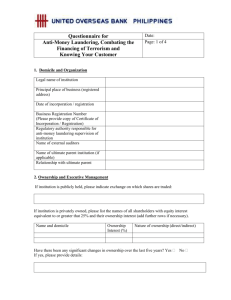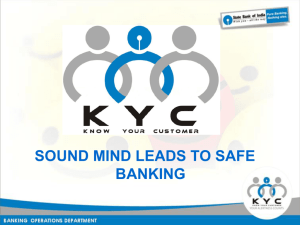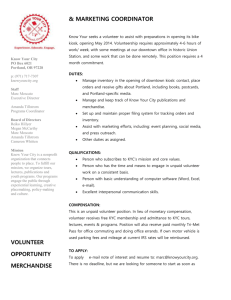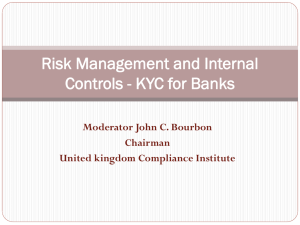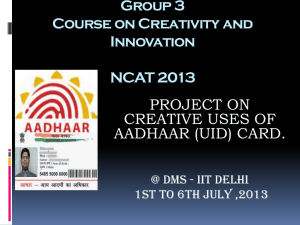Turn-the-KYC-Mar14-6
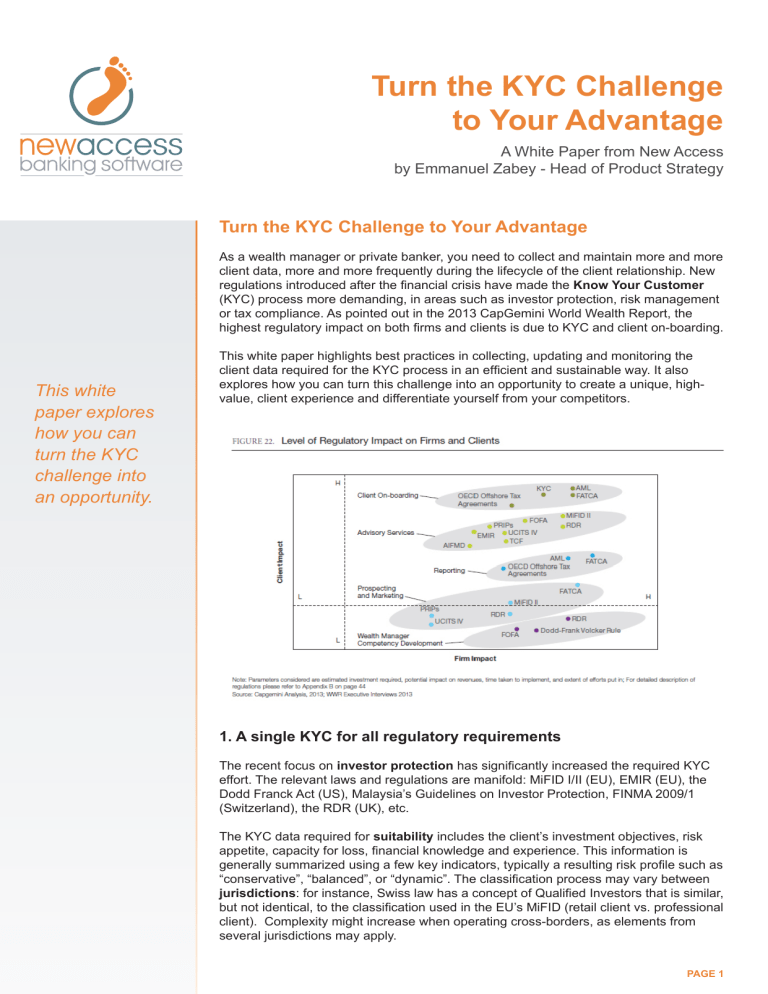
This white paper explores how you can turn the KYC challenge into an opportunity.
Turn the KYC Challenge to Your Advantage
A White Paper from New Access by Emmanuel Zabey - Head of Product Strategy
Turn the KYC Challenge to Your Advantage
As a wealth manager or private banker, you need to collect and maintain more and more client data, more and more frequently during the lifecycle of the client relationship. New regulations introduced after the financial crisis have made the Know Your Customer
(KYC) process more demanding, in areas such as investor protection, risk management or tax compliance. As pointed out in the 2013 CapGemini World Wealth Report, the highest regulatory impact on both firms and clients is due to KYC and client on-boarding.
This white paper highlights best practices in collecting, updating and monitoring the client data required for the KYC process in an efficient and sustainable way. It also explores how you can turn this challenge into an opportunity to create a unique, highvalue, client experience and differentiate yourself from your competitors.
1. A single KYC for all regulatory requirements
The recent focus on investor protection has significantly increased the required KYC effort. The relevant laws and regulations are manifold: MiFID I/II (EU), EMIR (EU), the
Dodd Franck Act (US), Malaysia’s Guidelines on Investor Protection, FINMA 2009/1
(Switzerland), the RDR (UK), etc.
The KYC data required for suitability includes the client’s investment objectives, risk appetite, capacity for loss, financial knowledge and experience. This information is generally summarized using a few key indicators, typically a resulting risk profile such as
“conservative”, “balanced”, or “dynamic”. The classification process may vary between jurisdictions : for instance, Swiss law has a concept of Qualified Investors that is similar, but not identical, to the classification used in the EU’s MiFID (retail client vs. professional client). Complexity might increase when operating cross-borders, as elements from several jurisdictions may apply.
PAGE 1
The automatic exchange of tax information is imminent.
Therefore the accuracy of KYC data will not only be a question of operational cost or fulfilling regulatory requirements, it will also impact clients’ privacy.
A far-reaching consequence of suitability regulation is the obligation to link KYC data to portfolio management . For instance, an initially suitable investment might become unsuitable for reasons as different as:
• A change in the client’s legal residence, to a stricter jurisdiction (KYC)
• A change in the client’s financial situation (KYC)
• A market fluctuation changing the asset allocation of the portfolio (portfolio).
In general, regulation imposes suitability controls both before and after the investment.
Beyond the regulatory aspect, being able to prove that the process took place is the only way to mitigate exposure to litigation and complaints. The number of investor protection cases has risen sharply in terms of poor governance, mis-selling and money infringements, resulting in large fines and reputational damage to many firms across the world.
In addition to suitability requirements, Anti Money Laundering (AML) obligations have become more stringent. Recent high-profile cases of defective AML handling, leading to heavy fines, have focused the industry’s attention on this area. As many regulations require firms to follow a special surveillance process for higher-risk clients, KYC data such as country of residence, country of activity or sector of activity is critical. Even if a firm does not get fined, the reputational damage of mishandling KYC can be significant, in particular if the client is a Politically Exposed Person (PEP).
Last but not least, recent tax regulations have shed new light on the operational cost of a defective KYC process, e.g. when implementing the FATCA electronic search for US indicia. The automatic exchange of tax information is imminent. Therefore the accuracy of KYC data will not only be a question of operational cost or fulfilling regulatory requirements, it will also impact clients’ privacy.
Many organizations are still implementing tactical solutions, reacting to each new piece of regulation on a case-by-case basis. Not only does this becomes very costly as time goes by, but adding on applications, processes, and repositories for every new requirement makes systems complex, redundant and difficult to maintain.
Client data (KYC)
Regulatory area
Personal
identification
Political exposure,
WorldCheck
Residence /
activity
Detailed account structure
(e.g. trust, LLC, etc.)
Identification of ultimate beneficial owner
Purpose of relationship
Investment objectives
Risk appetite / capacity for loss
Financial knowledge and experience
Portfolio
structure
Transactions
AML
X
X
X
X
Tax Investor compliance protection
X X X
X X X
X
X
X
X
X
X
X
X X X
X X X
Cross-border constraints / passporting / local regulation
X
X
X
X
X
X
X
Table 1 – Items of client data used in the various regulatory areas
Reputational
Risk
X
X
X
X
X
PAGE 2
Having solid
KYC tools and procedures for new accounts is a necessity, but so is developing a proper system for the ongoing monitoring of your clients and portfolios. This is where ad-hoc systems often fail.
Most regulatory requirements discussed above actually use the same underlying client data (see Table 1 above). Thus, having a single, well-designed and well-integrated client data management solution has many benefits:
• It avoids double input of the same data
• It eliminates the need for do-it-yourself solutions each time a regulation is updated
• It ensures that when a change occurs, all consequences are taken into account
(e.g. on suitability, on tax, on risk, etc.)
• It is cost-effective in terms of both development and maintenance
Your vendor should act as a true partner in helping you anticipate the impacts of upcoming regulations, and adapting your existing solution to these changes.
2. KYC in the lifecycle of the client relationship
KYC-related duties span the full lifecycle of the client relationship:
• During on-boarding , a complete picture of the client must be obtained: identity, personal background, business activity, source of wealth, taxation, investment profile, etc.
• Later in the relationship, the client may communicate changes of circumstances: new country of residence, changes in wealth or revenue, changes in investment objectives, etc.
• In addition, some events must be monitored that may not be directly communicated by the client but nonetheless require action, such as unexpected transactional activity (AML), a hit in a name check system (e.g. PEP), or suitability alerts on the client’s portfolio (investor protection).
Having solid KYC tools and procedures for new accounts is a necessity, but so is developing a proper system for the ongoing monitoring of your clients and portfolios.
This is where ad-hoc systems often fail.
In the long run, you need a manageable, reliable and integrated system with built-in change management and monitoring capabilities. Keep in mind that a single change, e.g. a new residence, may impact:
• The AML risk of the account, e.g. if the new country of residence is on a high-risk list
• The applicable rules of investor protection (e.g. MiFID in EU countries)
• The bank’s exposure to litigation with the client (e.g. the Dodd-Frank Act in the US)
• The bank’s exposure to litigation with the client’s new country of residence, depending on its cross-border rules & regulations
• The tax-related aspect of the relationship: you may need the client to prove tax compliance in his/her new country of residence, you may offer adapted tax reporting services, help your client claim benefits of double tax treaties, and change the nature of investments for the sake of tax optimization.
If all these questions are addressed in different systems, the operational cost of account maintenance may become high, and possibly unbearable, as clients increasingly live, operate and invest internationally.
Table 2 below illustrates how the different regulatory areas impact the on-boarding, change, and monitoring processes. Whereas the impact on on-boarding is the strongest, maintenance processes should not be neglected, especially as they are likely to happen repeatedly.
PAGE 3
A unified system minimizes cost and disruption in your business processes while ensuring appropriate action is always taken.
Business process
On-boarding
Regulatory area
Change of
circumstances
Monitoring
Impact
AML
Low
Tax Investor Cross-border Reputational compliance protection constraints Risk
Medium High
Table 2 – Impact of regulatory constraints on client on-boarding and maintenance
Unified systems like the New Access solution make it easier to handle all aspects of client on-boarding and maintenance. Relying on a business rule engine, the system will assist on-boarding and:
• Ensure all the required data and documents have been collected and/or signed
• Provide a risk classification of the client, possibly affecting the bank’s approval process
• Help verify that the new relationship is compliant in terms of tax, investor protection, cross-border legislation, the bank’s internal policy, etc.
If new circumstances are either announced by the client or detected by the monitoring engine, the system will assess their impact on all aspects of the relationship. Typical responses may be to:
• Trigger a specific business process (e.g. client profile upgrade)
• Issue a warning, to be reviewed and assessed by designated users (e.g. compliance); warnings will be presented as a short readable list for daily review and case-by-case decisions
• Simply track the event in the client’s log history; this log might be reviewed on a periodical basis
Such a system minimizes cost and disruption in your business processes while ensuring appropriate action is always taken.
3. Turning the challenge into an opportunity
As discussed above, on-boarding and maintenance processes that were once simple have turned into a heavy administrative burden for both clients and firms. Operational costs have risen to a point where the ability to generate new profitable business is becoming a challenge. Research by ComPeer (2013 UK Wealth Management Industry report) has shown that new regulation has not increased the size of compliance teams: the impact has been on the Front Office and Management who spend considerably more time dealing with compliance. However, these more challenging conditions have also created new opportunities .
First and foremost, clients are increasingly sensitive to the issues addressed by new regulations.
• They expect their bank or wealth manager to understand their needs, objectives, and appetite for risk. A transparent and well-conducted suitability process will actually build trust and encourage clients to invest.
• Many clients seek guidance in the complex world of tax , and expect their advisor to propose the optimal investments given their own specific circumstances. Tax expertise is a very strong selling point, especially with high net worth individuals.
• As the general trust of the public in the wealth industry is low, the cost of reputational issues is high. Even if a financial institution is not directly blamed, clients will not favor it if they have heard it mentioned in publicized scandals (e.g.
PAGE 4
Tax expertise has traditionally focused on regulatory compliance, but now it is also about bringing high addedvalue service to clients.
linked to politically-exposed persons).
• Recent years have shown that a financial institution can fail , due to poor risk management or exposure to litigation. Clients would rather avoid this risk and will therefore show preference for stable and well-governed institutions.
These examples show that industry players should not only be compliant with the new regulations: they should promote and advertise a culture of compliance, to secure clients’ trust. Tax is a clear case in point. Tax expertise has traditionally focused on regulatory compliance, but now it is also about bringing high added-value service to clients.
On-boarding is certainly a key time to show focus and capability in compliance matters.
In its 2013 World Wealth Report, Cap Gemini suggests that “to help guide clients through the new procedures, firms would benefit from making specific investments in areas such as automating parts of the on-boarding process and the hiring and training of knowledgeable and experienced relationship managers.” As legislation increasingly accepts the validity of electronic documents and electronic signature, a completely new experience can be offered to clients.
Electronic collection of KYC data is more efficient, can be done using mobile devices, and facilitates a valuable discussion that benefits the client . Electronic KYC data will:
• Pre-populate (digital) forms to be signed by the client
• Start filling in the client profile used for the firm’s approval process for new clients
• Allow the system to determine which documents the clients should sign and/or provide
• Allow the system to propose optimal investment choices, on both risk and tax aspects
• Warn the relationship manager about the risks of on-boarding this client, and help mitigate these risks.
This digital approach also reduces the duration of the account opening process : it avoids double-input, limits paper handling, and most importantly minimizes the risk of
“rework”, i.e., the relationship manager returning to the client due to missing information or documents. A well-designed electronic solution can reduce weeks of procedure into a few days. In fact, clients are increasingly starting to choose their financial institutions based on speed and efficiency to on-board, so getting this right is a clear competitive advantage. For companies interested in sustainability, it can also provide a reputational advantage in terms of reduced paper consumption.
A positive approach to the increasing KYC burden
The trends discussed in this white paper are not likely to be reversed anytime soon: regulatory pressure will continue to increase, and clients’ expectations of efficiency and personalization will keep growing. These changes are strong incentives to invest in optimal KYC data management.
The 2013 Cap Gemini World Wealth Report shows that tactical investments made by firms are largely focused on simply meeting regulatory requirements. As discussed above, these investments can bring much more value if they help generate business and bring benefits to the clients.
PAGE 5
Clients are increasingly starting to choose their financial institutions based on speed and efficiency to on-board, so getting this right is a clear competitive advantage.
Source Capgemini Analysis, 2013; WWR Executive Interviews 2013
An optimal solution for KYC data management will:
• Ensure regulatory compliance while keeping operational costs under control
• Have the flexibility to include new requirements with minimal impact on the system’s cost of ownership
• Make sure all the aspects of a change in the client’s circumstances are handled across your departments, from relationship managers to compliance, tax or legal services
• Assist your relationship managers in providing excellent advice and services proactively
• Increase your efficiency in meeting your client’s demands
• Personalize your communication to your clients through all channels
With a reliable technology partner, you can harness the power of the information that lies in your systems.
The author would like to thank Jann Regenass for his valuable insights.
For more information
Please contact: marketing@newaccess.ch
+41 22 879 99 11
New Access SA
12 avenue des Morgines
1213 Geneva
Switzerland
PAGE 6
